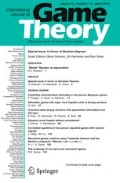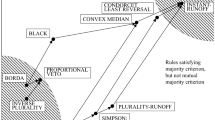Abstract
This article is devoted to the analysis of electoral systems involving two step procedures. It appears that designers are able to manipulate the result of these type of elections by gerrymandering, except in a very few cases. When imposing an unanimity condition on every jurisdiction’s voting rule, it is shown that, for any finite number of candidates, a two step voting rule that is gerrymander-proof necessarily gives every voter the power of overruling the unanimity. A characterization of the set of gerrymander proof rules is provided in the case of two candidates.
Similar content being viewed by others
References
Balinski M, Young P (1982) Fair representation. Yale University Press, New Haven
Banzhaf J (1968) One man, 3.312 votes: a mathematical analysis of electoral college. Villanova Law Rev 13: 304–332
Barberà S, Jackson MO (2006) On the weights of nations: assigning voting weights in a heterogeneous union. J Polit Econ 114: 317–339
Beisbart C, Bovens L, Hartmann S (2005) An utilitarian assessment of alternative decision rules in the council of ministers. Eur Union Polit 6: 395–418
Boumedienne-Thiery A, Duhamel O (2000) Le droit de vote des étrangers, une question européenne. Le Monde, 27 April 2000
Chambers C (2008) Consistent representative democracy. Games Econ Behav 62: 348–363
Feix MR, Lepelley D, Merlin VR, Rouet JL (2004) The probability of conflicts in a U.S. presidential type election. Econ Theory 23: 227–257
Felsenthal DS, Machover M (1999) Minimizing the mean majority deficit: the second square-root rule. Math Soc Sci 37: 25–37
Fine K (1972) Some necessary and sufficient conditions for representative decision on two alternatives. Econometrica 40: 1083–1090
Fishburn PC (1971) The theory of representative majority decision. Econometrica 39: 279–284
Fishburn PC (1973) The theory of social choice. Princeton University Press, Princeton
Gibbard A (1973) Manipulation of voting schemes: a general result. Econometrica 41: 587–601
Hartvigsen D (2006) Vote trading in public elections. Math Soc Sci 52: 31–48
Laffond G, Lainé J (1999) A general impossibility theorem on representative democracy. In: de Swart H (ed) Logic, game theory and social choice, proceedings of the international conference LGS99. Tilburg University Press, Tilburg, pp 504–521
Laffond G, Lainé J (2000) Representation in majority tournaments. Math Soc Sci 39: 35–53
Maaser N, Napel S (2007) Equal representation in two-tier voting systems. Soc Choice Welf 28: 401–402
May K (1952) A set of independent, necessary and sufficient conditions for simple majority decision. Econometrica 20: 680–684
Moulin H (1988) Axioms of cooperative decision making, monograph of the econometric society. Cambridge University Press, Cambridge
Murakami Y (1966) Formal structure of majority decision. Econometrica 34: 709–718
Murakami Y (1968) Logic and social choice. Dover Publications Inc, New York
Nurmi H (1999) Voting oaradoxes, and how to deal with them?. Springer, Berlin
Penrose LS (1946) The elementary statistics of majority voting. J Roy Stat Soc 109: 53–57
Perote Peña J (2005) Gerrymendering proof social welfare functions. Universidad de Zaragoza, Mimeo
Satterthwaite M (1975) Strategy proofness and Arrow’s conditions. J Econ Theory 10: 187–217
Young HP (1974) An axiomatization of Borda’s rule. J Econ Theory 9: 43–52
Author information
Authors and Affiliations
Corresponding author
Rights and permissions
About this article
Cite this article
Bervoets, S., Merlin, V. Gerrymander-proof representative democracies. Int J Game Theory 41, 473–488 (2012). https://doi.org/10.1007/s00182-011-0298-2
Accepted:
Published:
Issue Date:
DOI: https://doi.org/10.1007/s00182-011-0298-2




